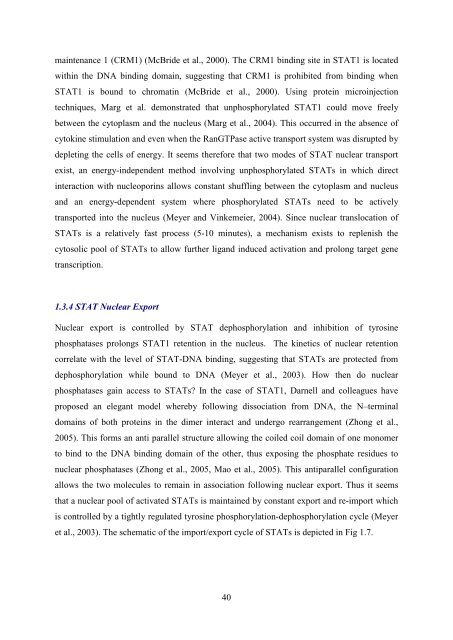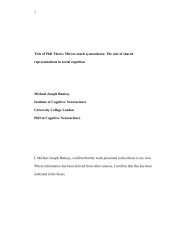Investigating the role of the JAK/STAT and MAPK ... - UCL Discovery
Investigating the role of the JAK/STAT and MAPK ... - UCL Discovery
Investigating the role of the JAK/STAT and MAPK ... - UCL Discovery
You also want an ePaper? Increase the reach of your titles
YUMPU automatically turns print PDFs into web optimized ePapers that Google loves.
maintenance 1 (CRM1) (McBride et al., 2000). The CRM1 binding site in <strong>STAT</strong>1 is located<br />
within <strong>the</strong> DNA binding domain, suggesting that CRM1 is prohibited from binding when<br />
<strong>STAT</strong>1 is bound to chromatin (McBride et al., 2000). Using protein microinjection<br />
techniques, Marg et al. demonstrated that unphosphorylated <strong>STAT</strong>1 could move freely<br />
between <strong>the</strong> cytoplasm <strong>and</strong> <strong>the</strong> nucleus (Marg et al., 2004). This occurred in <strong>the</strong> absence <strong>of</strong><br />
cytokine stimulation <strong>and</strong> even when <strong>the</strong> RanGTPase active transport system was disrupted by<br />
depleting <strong>the</strong> cells <strong>of</strong> energy. It seems <strong>the</strong>refore that two modes <strong>of</strong> <strong>STAT</strong> nuclear transport<br />
exist, an energy-independent method involving unphosphorylated <strong>STAT</strong>s in which direct<br />
interaction with nucleoporins allows constant shuffling between <strong>the</strong> cytoplasm <strong>and</strong> nucleus<br />
<strong>and</strong> an energy-dependent system where phosphorylated <strong>STAT</strong>s need to be actively<br />
transported into <strong>the</strong> nucleus (Meyer <strong>and</strong> Vinkemeier, 2004). Since nuclear translocation <strong>of</strong><br />
<strong>STAT</strong>s is a relatively fast process (5-10 minutes), a mechanism exists to replenish <strong>the</strong><br />
cytosolic pool <strong>of</strong> <strong>STAT</strong>s to allow fur<strong>the</strong>r lig<strong>and</strong> induced activation <strong>and</strong> prolong target gene<br />
transcription.<br />
1.3.4 <strong>STAT</strong> Nuclear Export<br />
Nuclear export is controlled by <strong>STAT</strong> dephosphorylation <strong>and</strong> inhibition <strong>of</strong> tyrosine<br />
phosphatases prolongs <strong>STAT</strong>1 retention in <strong>the</strong> nucleus. The kinetics <strong>of</strong> nuclear retention<br />
correlate with <strong>the</strong> level <strong>of</strong> <strong>STAT</strong>-DNA binding, suggesting that <strong>STAT</strong>s are protected from<br />
dephosphorylation while bound to DNA (Meyer et al., 2003). How <strong>the</strong>n do nuclear<br />
phosphatases gain access to <strong>STAT</strong>s? In <strong>the</strong> case <strong>of</strong> <strong>STAT</strong>1, Darnell <strong>and</strong> colleagues have<br />
proposed an elegant model whereby following dissociation from DNA, <strong>the</strong> N–terminal<br />
domains <strong>of</strong> both proteins in <strong>the</strong> dimer interact <strong>and</strong> undergo rearrangement (Zhong et al.,<br />
2005). This forms an anti parallel structure allowing <strong>the</strong> coiled coil domain <strong>of</strong> one monomer<br />
to bind to <strong>the</strong> DNA binding domain <strong>of</strong> <strong>the</strong> o<strong>the</strong>r, thus exposing <strong>the</strong> phosphate residues to<br />
nuclear phosphatases (Zhong et al., 2005, Mao et al., 2005). This antiparallel configuration<br />
allows <strong>the</strong> two molecules to remain in association following nuclear export. Thus it seems<br />
that a nuclear pool <strong>of</strong> activated <strong>STAT</strong>s is maintained by constant export <strong>and</strong> re-import which<br />
is controlled by a tightly regulated tyrosine phosphorylation-dephosphorylation cycle (Meyer<br />
et al., 2003). The schematic <strong>of</strong> <strong>the</strong> import/export cycle <strong>of</strong> <strong>STAT</strong>s is depicted in Fig 1.7.<br />
40
















